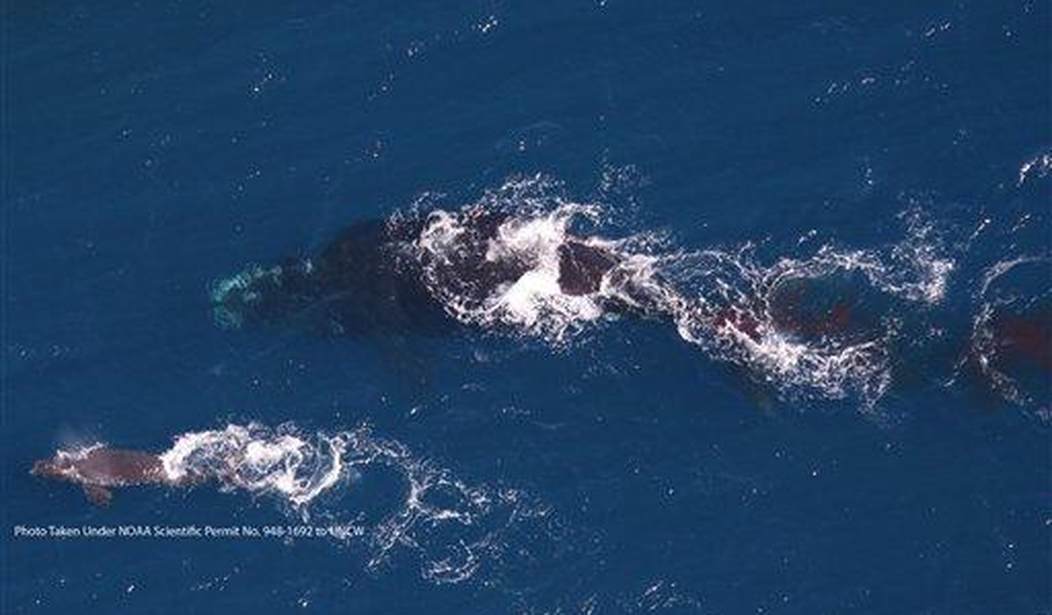Wind energy is presented by climate alarmists as a planet saver – a friend of Earth’s flora and fauna. Nothing could be further from the truth, which is becoming more apparent with increasing deaths among whales along the United States’ East Coast.
Though dismissed by official agencies charged with wildlife protection, evidence is pointing to offshore wind projects as threats to whales, especially the endangered North Atlantic right whale.
Wind turbines are well known as killers of aerial fauna, with one study reporting the deaths of 888,000 bats and 573,000 birds as the result of wind machines. Now the images of mangled bald eagles are being joined by pictures of whale corpses mysteriously – or perhaps not so mysteriously – washed ashore on beaches stretching from Maine to Florida.
The National Oceanic and Atmospheric Administration (NOAA) reported an “unusual mortality event” as the result of elevated humpback whale deaths since January 2016 along the East Coast. The agency reports 180 humpback “strandings” during the period, including seven already in 2023. The peak year was 2020 with 33 strandings. Of 13 Atlantic Coast states having strandings, Massachusetts and New York have had the most – 35 each. North Carolina, New Jersey and Virginia totals are in the mid-20s.
With respect to the cause of death, NOAA says, “A portion of the whales have shown evidence of pre-mortem vessel strike; however, this finding is not consistent across all whales examined. More research is needed.”
However, NOAA refuses to acknowledge a connection between whale mortality and the site-development activities of offshore wind projects: “ At this point, there is no evidence to support speculation that noise resulting from wind development-related site characterization surveys could potentially cause mortality of whales. There are no specific links between recent large whale mortalities and currently ongoing surveys for offshore wind development. We will continue to gather data to help us determine the cause of death for these mortality events.”
Recommended
However, researcher Dr. David Wojick calls NOAA’s position “ridiculous.” Writing at CFACT, he says that the agency is saying, “We know nothing about it so it must not be happening.”
Dr. Wojick says that the “claim that this huge jump in mortality predates offshore wind preparation activities is wildly false. In fact, it coincides with the large-scale onset of these activities.”
“This strong correlation,” he says, “is strong evidence of causation, especially since no other possible cause has appeared…2016 also saw the beginning of what are called geotechnical and site characterization surveys (using sonar). These surveys are actually licensed by NOAA Fisheries, under what are called Incidental Harassment Authorizations or IHAs.”
In other words, whale injuries and deaths by wind projects are legalized and permitted under the IHA licenses issued by NOAA. Wojick notes that “the huge 2016 jump in annual humpback mortality coincides with the huge jump in NOAA Incidental Harassment Authorizations.”
As a protected species, the North Atlantic right whale gets special attention. NOAA estimates that fewer than 350 remain in the oceans. The name originates from the days of whaling when the leviathan was identified as the right whale to kill, its high blubber content not only being commercially valuable but a source of buoyancy that allowed the carcass to float and be more easily retrieved.
Their population never having recovered to pre-whaling levels, right whales now are threatened by fishing net entanglements and ship strikes. Without referencing wind energy development, NOAA says, “Increasing ocean noise levels from human activities are also a concern since the noise may interfere with right whale communication and increase their stress levels.”
In addition to experiencing an unusual mortality event since 2017, the right whales’ frequency of birth has dropped below the death rate. The 70 breeding females are now having calves only every six to 10 years.
According to NOAA, the right whale’s critical habitat is in approximately 29,763 square nautical miles in the Gulf of Maine, the Georges Bank region between Cape Cod and Nova Scotia and off the Southeast coast. The survey area for wind energy projects overlaps the region.
For purposes of project approvals, NOAA’s accepted human kill rate for right whales is 0.7 per year. However, currently two whales a year are dying. NOAA is authorizing IHA licenses for right whale habitat while ignoring the kill rate as well as evidence of the threat of sonar surveys and other wind-energy activities.
It is reprehensible to put these animals at risk to advance an overpriced, unreliable technology like wind turbines as a lame response to a fabricated climate emergency. Environmental organizations ignoring the issue have truly lost their way.
The CO2 Coalition recommends a halt of offshore wind energy projects, especially ones surrounding the critical habitats of North Atlantic right whales. It is these creatures that face a crisis, not people anticipating a warming of one or two degrees that is well within daily variations between breakfast and lunch.
Gregory Wrightstone is a geologist; executive director of the CO2 Coalition, Arlington, Va.; and author of “Inconvenient Facts: The Science That Al Gore Doesn’t Want You to Know.



















Join the conversation as a VIP Member